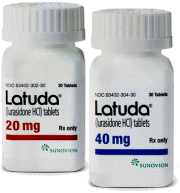
SUMMARY TO DATE:
| Lurasidone [Latuda®]
|
|||
| 0109/27/2011 | ought to know by now… | 0702/14/2014 | or both… |
| 0211/28/2011 | in the shadows… | 0802/15/2014 | creepy… |
| 0311/30/2011 | hiding uptown…, more… |
0902/16/2014 | sign it now!… |
| 0412/01/2011 | wait… | 1002/20/2014 | on time… |
| 0512/01/2011 | their choice… | 1108/14/2014 | under some of the rocks… |
| 0607/01/2013 | the mother of meta… | 1202/15/2015 | a perfectly good nap… |
The first article in the American Journal of Psychiatry had only one academic author [Vanderbilt’s Herbert Meltzer]. The remainder were industry employees, a ghost writer, and a vice president of the Quintiles Contract Research Organization. The study itself showed "spotty" efficacy. Looking at the FDA’s New Drug Application evaluation, the results of all five submitted studies were equally "spotty" – so much so that the FDA evaluator recommended against approval. But the head of the FDA over-rode her conclusion and the drug was approved.
Because a Quintiles vice-president was an author, I originally assumed that Quintiles had done the study, but it turned out that it was actually conducted by a Clinical Research Center in the wrong part of Chicago affiliated with the notorious Dr. Michael Reinstein. Known as the Clozaril King,: he finally lost his medical license over his shady [and lethal] dealings. Quintiles had entered the picture after the study was completed, I presume to legitimize the study and clean it up for publication. The molecule itself had been developed by a small group, gone through several companies and mergers, and finally ended up being marketed by a company formed out of the various mergers and aquisitions, Sunovion Pharmaceuticals.
[01-05] So in that first round, my own conclusion was that this was at the bottom of the barrel: a molecule that had been passed around for years; shaky trials; guest·authored, ghost·authored, and jury-rigged articles; topped off by shifty handling by the FDA – a shameful chronicle and testimonial to the worst of CNS PHARMA. The ad campaign featured a smiling after patient and his beaming mother which was then photo·shopped to provide the before image. I thought of this whole story as photo·shopped science.
[06-12] A meta·analysis a few of years later located it at the bottom of the list, so I was kind of surprised when I read [again in the American Journal of Psychiatry] that Sunivion was promoting it through the the indication creep pipeline, seeking approval for bipolar disorder etc. The articles were as obscure as the earlier set, but the FDA documents were not in Drugs@FDA like for the earlier Schizophrenia submission. So I submitted an FDA Freedom of Information Act [FOIA] request in February 2014 – sticking to my resolve to follow Latuda® through its patent life. A couple of weeks later, I was awakened from a nap. The FDA was calling. The lady on the phone got right to the point. She was calling to try to get me to withdraw that request – the FDA being so busy and all. I declined, asking how long it would take. She said a year and a half to two years. She seemed irritated.

THIS WEEK:
The DVD arrived in Wednesday’s mail from the FDA, some 19 months after submitting the request. At first, I didn’t even know what it was. I’ve spent the last couple of days reviewing what I wrote about previously and looking at the linked documents. It has been so long that I only recalled the high points [maybe I should say, the low points] along the way. I haven’t yet looked at what’s on the disk, figuring there’s no emergency in this little quest of mine. If you’ve even made it to this point in this post, I expect that you’d agree that this is pretty boring and monotonous stuff. And I doubt that anybody is waiting with bated breath to hear what the disk has to say [myself included]. And I sure don’t know how to photo·shop these posts into something flashy and interesting.
The FDA took time from its busy schedule to ask you to back off Latuda? Interesting.
Wonder why the head of the FDA took such an interest in approving it.
Alto,
Here’s Dr. Laughren’s 12 page “overview” answering your question. And then there’s Cara Alfaro’s 210 page original “medical review“. He doesn’t exactly say why…
He liked two of the studies.
The drug is being pushed hard for mood disorders and weight neutrality. I have seen Joe McEvoy’s name on papers. I hope you keep going. This is helpful.
It’s very popular among my colleagues at my particular big hospital complex, but I don’t know why. They seem to favor the newest drugs over older ones.